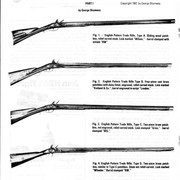Canuck Bob said:
It took awhile to research but trade rifles seem to be an American effort. Begs the question is there a traceable link from American trade rifles and the rise of the Plains and Mountain rifles of the west. It seems the late era muzzleloaders from the future Canadian region traded smoothbores almost exclusively.
Most rifles traded to Indians were made in America, but not all. Sometime before the American Revolution, trade rifles had reached a level of popularity with the Indians, that trade companies started having copies of an early Lancaster rifle made in England.
A number of these English made Lancaster trade rifles have survived. Unfortunately, not much period documentation about them has been found. De Witt Bailey provides a little.
De Witt Bailey said:
British Military Flintlock Rifles 1740-1840[/i]] As mentioned earlier, most of the rifles carried by American Indians in the period 1755-1778, whether or not in British Service, were of local American manufacture, and will be indistinguishable from those made for the ordinary commercial trade. That some rifles were imported from England for the Indian trade prior to 1775 is also clear, but the only details thus far to come to light are those concerning the Ohio Company's dozen rifles at Rock Creek in 1757, with 48-inch barrels and iron furniture...Between 1778 and 1783, it is equally clear that the origin of rifles carried by the Indians shifted from America to England.
Baily goes on to discuss the history of the gun making firm started by Richard Wilson and makes mention of invoices dating to 1781 where the British government purchased 312 rifles from the firm of Wilson & Co. that were intended for the Indian allies of the British during the AWI.
The invoices describe three different types of rifles:
108 Best Rifle Guns with brass boxes moulds & cases---53/6
156 Best Rifle Guns wood boxes moulds & cases---52/6
48 Rifle Guns wood boxes moulds & cases---50/-
George Shumway wrote a series of articles on these "English Pattern Trade Rifles" beginning in the February 1982 issue of
Buckskin Report.
It's unsure where these English trade rifles were shipped prior to the AWI, but it is clear that they found their way to the tribes in western New England, in the Great Lakes Region, and in the Ohio Valley. They could have been imported through Montreal, Albany, and/or Philadelphia. Some may have gone to the south through Charleston. Some tribes served as middlemen and traded European goods, including guns, to other tribes further west and north.
The style of English trade rifle changed towards the end of the 18th century and early 19th century. The early patterns like the first three in the illustration above had wide butt plates, a cheekpiece with a straight lower edge, and some decorative carving. They were essentially direct copies of an early Pennsylvania longrifle.
The bottom rifle reflects the general change in longrifles to narrower butt plates. It also has a curved lower edge on the cheekpiece. These rifles have a more military look to them.
Shumway gave this latter pattern the designation of "Type D". Bailey calls it the "Pattern 1813 Indian Contract Rifle" because he found records that the British Board of Ordnance awarded contracts for rifles of this pattern in 1813 to supply British Indian allies during the War of 1812. Private traders were undoubtedly ordering guns of this pattern prior to the War of 1812, though.
The English trade rifle was apparently quite popular with the Indians in the West. When J.J. Henry inquired about the possibility of supplying the American Fur Company with trade rifles in 1825, William Astor wrote back, "we continue to import a part of those [rifles] annually required for our trade but we usually get 100 or 200 manufactured in the United States and it will depend much on both price and quality whether we do not in the future procure the whole quantity in this country." The AFC was importing all their North West guns from England at this time, and the import rifles were surely English-made as well.
By 1828, J.J. Henry had copied the English Type D trade rifle and was selling them to the AFC.
The process had gone full circle. The English copied the Lancaster longrifle before the AWI because of its popularity with the Indians, modified it over the subsequent decades into a truly English form, which Henry in turn copied because of its popularity with the Indians of the 1820's.
I don't believe very many of the North West Company records survive today. We can only speculate that they ordered some English trade rifles, too. The North West Company controlled the trade around the Great Lakes prior to the War of 1812, and pushed it into western Canada and all the way to the Pacific coast. After the War of 1812, they would have been competing directly with American fur companies as well as the Hudson's Bay Company. If Astor's customers wanted English trade rifles, then the North West Company had likely introduced the rifles to those same customers.





